Test Your Knowledge: Traffic Stops, Lights, and Officer Safety
Officers must be on high alert at every moment during each and every traffic stop. Actually, they must remain in that heightened state of “ready for anything” from the moment they activate their blue lights until the stop is complete and they’re back in the safety of their patrol cars and the stopped vehicle is on its way..
After all, officers never know what to expect. A driver could be wanted for a serious crime, such as murder or rape or threats against the lives of police officers. Is he carrying dangerous drugs or other contraband? Is he armed? Are there explosives in the car? Is this an ambush? Suicide by cop? The list goes on and on.
Police academy instructors teach recruits how to be safe. They set up mock exercises simulating scenarios that officers could encounter once they hit the streets. Role-playing is a big part of academy training. Still, all the training in the world cannot cover every real-life situation. No two traffic stops are the same, nor are any two calls.
In spite of the intense training, traffic stops are one of the most dangerous duties of police work. There are many unknowns. Too many. And the danger level is amplified many times when stopping a car at night.
Imagine that it’s 2 a.m. and you’re patrolling a lonely stretch of highway when you spot a black SUV parked on the shoulder of the road. Headlights and brake lights are both on. The driver, of course, has his foot on the pedal, meaning at least one person is inside the vehicle.
You pull in behind the car and flip the toggle switches to activate your blue strobes and takedown lights (to let them know you’re a police officer and to illuminate as much of the area as possible). *See bottom of page for more takedown lights.
Then, after sizing-up the situation, you step outside and immediately hear loud music blaring from the car’s speakers. The car’s windows are tinted black and you can’t see inside, but the motions of the vehicle tell you people are moving around.
To make things even worse there’s no moonlight or streetlamps. For all you know, the driver and an unknown number of passengers could be pointing machine guns at you. Your nearest backup is a good twenty minutes away. Believe me, it’s unnerving, to say the least.
Each officer has his/her own way of doing things and they often develop routines to help avoid missing details. The officer in the picture above, for example, has positioned her patrol car on an angle to the roadway, with the front tires also angled out toward the street. Any idea why she chose do park her patrol car in such a way?
Patrol car parked on an angle

Patrol car parked on angle with wheels pointed out.
She has her left hand on the trunk of the car. Why not her right hand? She’s looking ahead at the passing car while keeping the driver in her line of vision. She’s standing a certain way. Actually, it appears that she’s doing everything right. Good for her, because she had no idea a photographer was behind her. We were pretty sneaky.
Hand on the trunk
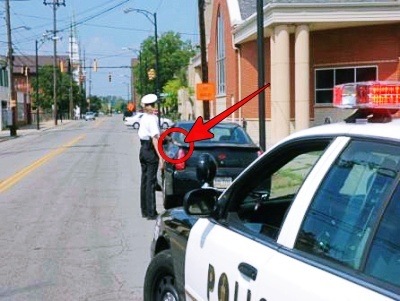
Left hand on trunk lid. Right hand free. Body angled as well.
Wait a minute. If a camera-toting writer and her supervisor could sneak up behind her … well, why couldn’t a cop killer do the same? The answer is yes, and it’s extremely important hat officers remain aware of all surrounding while approaching a car and while dealing with the driver, passengers, traffic, pedestrians, etc.
Okay, enough of my rambling. It’s time to put the shiny shoe on the other foot. I’m asking each of you to tell me why the officer decided to do the things she’d done. And, is there anything else she could have done to ensure her safety?
Remember, she wants to go home at the end of her shift, and she wants to make it there without any bullet holes perforating her body.
Light Bar
The light bar on the vehicle’s top features white takedown lights (front), and side alley lights. These lights are merely white spotlights that’re used to illuminate specific items, or people, during traffic stops and other situations. Alley lights can be switched on to illuminate areas to the side of the patrol car, allowing the officer to see down alleyways, inside store windows and door areas, yards of residences, etc. An excellent tool for patrol officers.
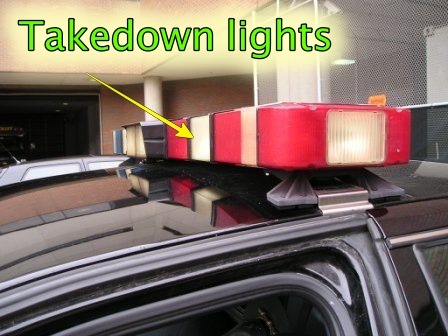
Takedown lights
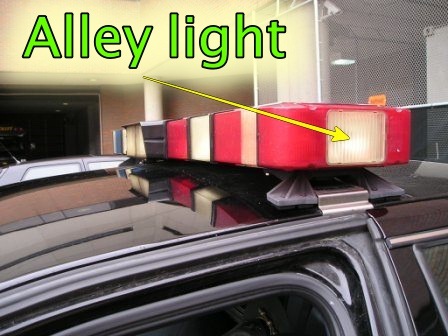
Alley lights
In addition, they have use of a movable spotlight that’s mounted to the driver’s side between the doorframe and windshield. Officers sometimes store an extra set of cuffs on the spotlight control arm.

Here’s an interesting point to note for writers who’re searching for a bit of flavor to a scene.
While driving along, especially on bumpy and curvy roads, etc., there’s a constant “click” of metal tapping metal as the handcuffs hanging from the spotlight arm sway with the motions of the car. After a while, though, the noise is “tuned out” and simply becomes a part of the cacophony of sounds inside the patrol vehicle—constant police radio chatter, FM radio station, the drunk yelling and singing from the backseat, and even a partner going on and on about his kids or the big fish he caught, or the mangled dead body they’d discovered at a crash scene earlier in the night.
The light bar is also equipped with red and/or blue emergency lights. Some light bars are equipped with speakers for the siren (siren horns are also mounted behind the front grill). Other light bars contain hidden radar antennas. The positioning and style of light bars depend on the individual department policies.
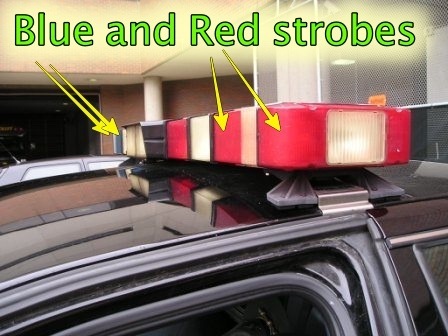
Light colors and the combination thereof may be dictated by state or local law. Such as, in Virginia:
Code of Virginia
§ 46.2-1022. Flashing or steady-burning blue or red, flashing red and blue or blue and white, or red, white, and blue warning lights.
Please help me
I need your help. I’m desperate. Truly desperate.
Our daughter has been in an exhaustive battle with cancer for just over a year. She’s a real fighter and her last scan showed no signs of the disease. Excellent news, believe me. A miracle, actually, But her troubles didn’t stop there. She’s still very ill and weak and is suffering greatly from the effects of chemo and radiation.
Hospital, doctor, and pharmacy bills are over the moon. She just received two bills totaling over $13,000, her part of the bill after insurance paid theirs. Ellen’s family is experiencing a financial crisis. In addition to the cancer-related expenses, she had surgery on both eyes this week, and their home and property experienced damage during the recent hurricane. Part of that damage caused their septic system to fail. They now must use a port-a-john that’s situated at the end of their drive way. They pump water from their bathtub and sink using a sump pump. Having cancer woes is bad enough, but to have to go outside to an outhouse in the middle of night during the winter is awful.
Paying everyday bills along with the mountain of medical bills and insurance premiums is a juggling act just to keep utilities working and switched on.
Now it’s Christmas time, Ellen’s favorite time of the year. She cherishes it, actually. She missed last Christmas due to treatments. She has no memory of it at all. The same for much of the past year.
This year she’s well enough to enjoy the holidays. However, her husband, who’s the sole wage-earner, has been working reduced hours and, as a result, they often have to supplement his pay so that their health insurance will continue. Yes, he’s actually paying the company because he’s not earning enough to cover insurance. His company had to reduce hours because they make parts for GM vehicles and, as you’ve probably heard, GM is closing plants and laying off workers. Having to pay to work at the company means there’s no money for food, heat, water, gas, etc. Sometimes it’s less than no money.
They have a teenage son who’s trying to help out, but he missed two months of school after the hurricane destroyed much of his school.
Their gym and training area is still closed, meaning he and his teammates have no place to train and to prepare for matches with competing schools.
Tyler’s longterm goal is to earn a wrestling scholarship so he can attend college. He’s aware of the devastating effect that cancer has been on family finances. His sights are also set on the Olympics.
So, like a true champion, he borrowed mats from his coach and rolls them out in his backyard where he and a few of his teammates practice on their own time and as often as they can.
Tyler, a true champion, recently first place at the Swiss Bear Wrestling Classic. He won the 170 title match via a 52-second pin over the final competitor. Last weekend he won the gold in his weight class at the massive Beast of the East wrestling tournament. 178 wrestlers competed with only 14 winning the top spots.
Ellen and her family are true fighters but currently they’re at the bottom of a very large and extremely steep hill. With nowhere else to turn for help I’ve come to you. So if you can, please. No amount is too small or large. Anything to help them at least experience a good Christmas.
From the bottom of my heart, thank you.
Please click here to contribute (it’s Ellen’s GoFundMe page).

Ellen, my sweet little girl. Always.


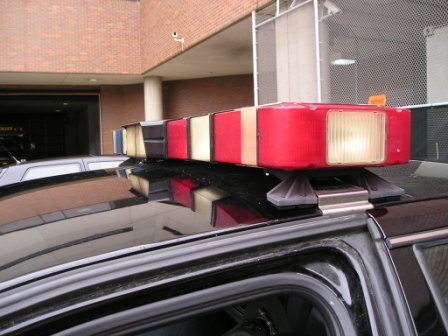
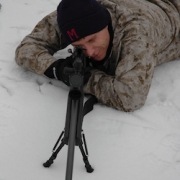
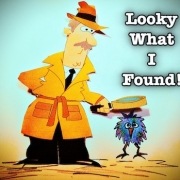

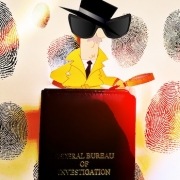



The patrol car and wheels are angled in such a way that, if hit from the rear by another motorist, the patrol car won’t move straight ahead and hit the officer (the angling would cause it to swing outward).
The hand is on the truck to make sure it’s closed. Otherwise, the trunk could look closed but not be fully latched, allowing someone to hide there and spring an ambush on the officer.
Am I right?
Lee, I’m thinking that the officer has her wheels turned outward in case she has to take off in pursuit. I think she’s turned in that direction with her left hand on the trunk in case she needs to go for her weapon. I don’t know why she has her hand on the trunk– for balance perhaps? Would love to know these answers. Thank you!
Excellent overview, and loved that detail of the clicking handcuffs! Happy Holidays to all~